Essay on PeacockThe peacock is India's national bird. It was selected as the country's national bird on January 26, 1963. The peacock is the biggest flying bird amongst birds and the heaviest in weight. It has a tiny mouth but a massive body and its neck is narrow and lengthy like a jug. The peacock can be found across India and is a sight to behold. Peacock can also recognise its presence in Indian culture and way of life. Its beauty impresses everyone. The peacock is mainly found in forests and fields, and it is frequently spotted close to the water and is more common in Indian agriculture communities. Peacocks utilised their hollow wings in the job of writing by soaking them in inks. Its feathers are as silky as a velvet fabric. 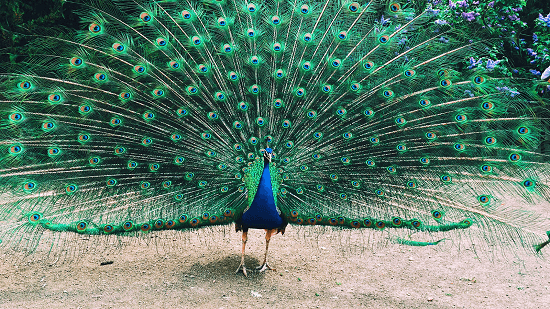
The peacock is essential in Hinduism as Lord Krishna wears a peacock feather on his forehead and the peacock is also the carrier of Lord Shiva's son Karthik. It is a group-living bird that frequently rests mostly on branches of large trees such as peepal, banyan, and neem. Its skin is brightly coloured with shades of blue. The peacock is also known as Neelkanth because of the bluish tinge of his neck, and their eyes are tiny and black. The peacock is a male bird, whereas the peahen is a female bird. The peahen is not particularly attractive, and it lacks large wings. The peacock has nearly 200 feathers in the form of a moon. It is intelligent, careful, and quiet, as well as gorgeous. It wants to be alone and keeps a good distance from people. When the rainy season comes in India, the peacock applauds, extends his feathers, and starts dancing slowly, which is both lovely to observe and attractive to female peacocks. Cultural ImportanceThe creator of the Mauryan Dynasty, Chandragupta Maurya, was born in an orphanage and reared by a peacock farming family. As per Buddhist legend, the Maurya monarchs' predecessors arrived in a location where peacocks were numerous. Per another Buddhist story, these predecessors created a city called Moriya-Nagar, because its stones were coloured, such as the necks of peacocks. The peacock was its official symbol till Ashoka transformed this into a lion, as shown in the Lion Capital of Ashoka and his rules. Both the Burmese and Sinhalese zodiacs feature the peacock. According to the Sinhalese, the peacock is the third animal in Sri Lanka's zodiac. Habitats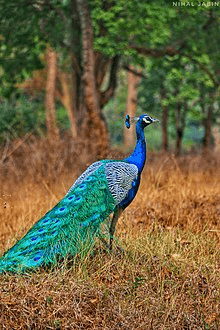
The Indian peacock breeds throughout the Indian subcontinent and in the dry grassland portions of Sri Lanka. It is found in damp and dry deciduous forests, although it can adapt to living in cultivated areas and near various habitats, and it is frequently found where there is rainfall. It is mostly found on the Indian subcontinent under a height of 1,800 m and, in rare circumstances, over 2,000 m. Peacocks are polygamous, and their nesting season is irregular but seems weather-dependent. Several male peacocks may cluster at a lek location, and these guys are frequently connected. In mating, a male peacock raises their top half coverts into an arching fan. The wingspan is kept partially open and slipped down while the long feathers vibrate, making a ruffling sound. FeedingPeacocks consume grains, bugs, berries, small animals, and snakes. They eat little snakes and stay away from larger ones. A huge proportion of their diet in Gujarat's Gir forest is mainly composed of dropped Ziziphus berries. It is very fond of agriculture and house plants in rural areas. Status of PeacocksIndian peacocks are extensively spread in nature throughout Southern Asia and thus are conserved both culturally and legally in so many regions. Conservative population figures place them at more than 100,000. Hunting of peacocks for their flesh and feathers, as well as unintentional poisoning from pesticide-treated seeds, are well-known hazards to wild birds. Birds may be a problem for farming in certain areas of India because they harm crops. Its negative impacts on crops appear to be countered by the useful function it plays in devouring massive amounts of pests such as grasshoppers. Peacock in our CultureThe peacock, significant in so many societies, has now been utilised in several iconic representations, including being named India's national bird in 1963. Mayura is a Sanskrit word derived first from the root mi, which means "snake killer." The Peacock ThroneThe Peacock Throne was a magnificent jewelled throne that served as the seat of the Mughal Empire's monarchs in India. Shah Jahan governed during the Mughal Dynasty's Golden Period, practically spanned the entire Indian subcontinent. He reigned from Shahjahan Abad, the newly built capital. The emperor served as the centre of attention, granting audiences and hearing requests. Large quantities of real gold, precious stones, and pearls were employed to create a masterwork of Mughal craftsmanship that was unrivalled before or after its creation. This new throne stood in sharp contrast to Jahangir's former throne, a big rectangular block of carved black basalt created in the early 17th century and used by Shah Jahan's father. On March 22, 1635, the ceremonial 7th anniversary of Shah Jahan's reign, the Peacock Throne was launched in a triumphal event. Physical Appearance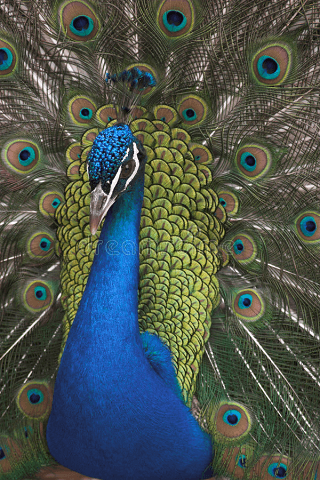
Peacocks are males of one species. They have a lovely appearance. As a result, the bird has gained extensive international acclaim. It is also 195 - 225 cm long from the end of the head to the end of the platform. It weighs about 5 kg on average. The dazzling blue colour of a peacock's forehead, throat, or chest is most noticeable. Peacock got white spots all across their eyes as well. The bird's back is sprouting 200+ display feathers. These feathers are frequently found on the extraordinarily long upper tail. Train fur has no spikes to keep feathers in place. As a result, the link between the feathers is shaky. In the shade, the peacock's back feathers are grey-brown. Another critical point to remember is that the feathers on the back were small and narrow. Facts about Peacock
Colouration of StructureMany species' bright glossy feather colours aren't principally pigments but structural colouration. There are 2D photonic-crystal structures inside the layers or surface area of those similar distinct groups that are usually in charge of the colouration of their wings. Variations in the Design"Spalding's" are hybrids of Indian and Green peacocks named after the first guy to crossbreed them properly. Spalding's, unlike many hybrids, are fertile and advantage from hybrid strength. Spaldings with a high-green phenotype do far better in cold temperatures than the cold-intolerant green peafowl while appearing like their green parents. White, purple, Buford brown, crystal, dark, grey, jade, and taupe are among the colour variants, while the intimate relations with colours like purple, cameo, peach, and Sonja's Violeta. Alternately, coloured peafowl are hatched uniquely coloured than jungle peafowl, and while each colour is distinguishable at hatch, their peachick appearance does not always match their adult appearance. White Peacock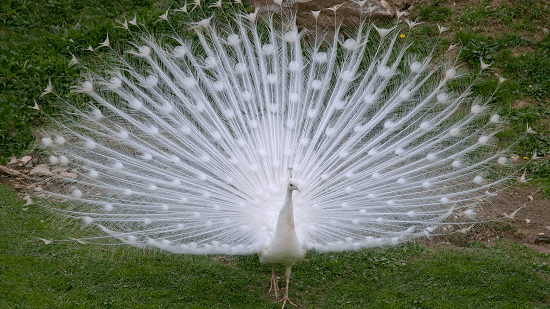
White Peacocks are born with yellow fur and blue eyes. Within a few days, the white peachick's feathers gain white tips. Pure white wings replace the yellow fur as they age. Before the age of one year, White Peachicks are difficult to determine. The White Peacock will grow silky and converted at this stage, and the male may have larger legs. White divided peachicks will match Indian Blue Peafowls but will have white wing ends. Black Shouldered PeacockThe Black Shouldered Peacock was imported to Europe in the 1800s. The Indian Blue Peacock pattern variation gave rise to the Black Shouldered Peacock. The Black Shouldered Peacock has a lovely appearance. They are not the same as the Indian Blue Peacock. Black Shouldered Peacocks are creamy in colour with a rust throat and dark-green colouration. A yard, field, or farm can be a haven for black-shouldered peacocks. The Black Shouldered Peacock chick is born yellow, and the forewing ends turn to a bronze colour in less than a day. Over the first three years of its existence, the peacock progressively removes its white colouration over its body. The plumage of the male black shoulder peacock darkens as it matures. Real Black Shouldered Peacock will pair with real Black Shouldered Peacock. When Indian Blue is crossed with Black Shouldered Peafowl, the outcome is either Indian Blue Peacock or Black Shouldered Peacock. Java PeacockThe Java Green Peacock is unique in the peacock family since both the male and female appear identical. Both genders have lengthy top tail coverts that hide the true tail beneath and glossy greenish necks that look like scales. These may grow to be two metres long in males, and the Java Peacocks usually migrate at the end of the regular season. The Java is the quietest peacock breed. The biggest of the peafowl breeds is a male bird measuring about 1.8 and 3 m in length, including the tail tip. Because it is a powerful bird, it can fly for long distances. Java Peacock HabitatJava Green Peacocks are migratory and cannot be permitted to walk freely within the United Kingdom. They are shy and must be cared for by an experienced individual. The UK confines Java peacocks and offers enough shelter from the elements. Spalding PeacockSpalding peacock was created by combining different peacock species. The crossbreed between Black Shouldered Peacock and Java Green Peacock forms Spalding Peacock. Spalding Peacock is called for the late Mrs Spalding of California. Spalding peacock chicks produce substantially bigger eggs than Indian Blues or other peafowl species. Spalding White, Spalding Burford Bronze, Spalding Lavender, Spalding Moonlight, Spalding Black Shoulder, and Spalding Pied are only a handful of the peafowl variants that have been produced using the Spalding gene. Indian Blue Peacock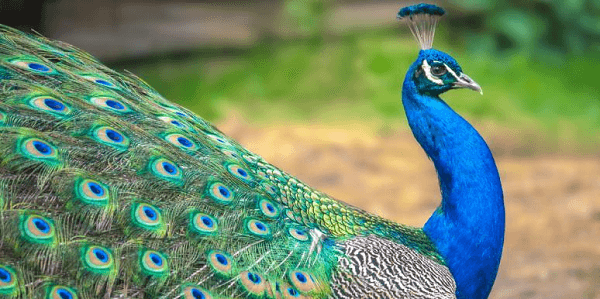
Indian Blue Peacock may be found in forests in the Indian Subcontinent, Sri Lanka, and Southern Asia. The Indian Blue Peacock has evolved to live in agricultural production, typically near water. The Indian Blue Peacock is brown with a shiny green band across the throat. Peacocks may survive in society for up to 23 years, although in the forest, they usually only survive for about 15 years. Cameo PeacockThe Cameo Birds has a tone variation that first appeared in the United States in the 1960s. Male Cameo Peacocks are creamy brown with richer chocolate brown spine hairs. Cameo Peacock chicks develop in a significantly lighter shade than Indian Blue Peacock chicks. The Cameo Peacock's wings begin to fade dramatically over the season and lose their colour scheme. Male vs FemaleThe name "peacock" usually refers to both male and female birds. However, peacocks are exclusively used for males. Females are known as peahens, and the group as a whole is known as peafowl. Appropriate males may form multiple wives of numerous females, each of which will deposit 3 to 5 eggs. In reality, wild peafowl frequently roosts in forest vegetation and assemble, commonly known as parties. Female PreferenceThe peacock's train and iridescent plumage may be the most well-known examples of features said to have evolved through sexual selection. However, this is debatable. To attract females, men peacock erects their tails to make a dazzling fan. Marion Petrie studied the wildlife of peacocks at Whipsnade Wildlife Park in southern England to see if these behaviours indicated a male's genetic quality. Females become less interested in trimmed males and more interested in untrimmed ones. Population of PeafowlThe green peacock's population decreased drastically during the last half of the twentieth century due to overexploitation and the loss of huge portions of its natural environment. The species is currently considered to range between 10,000 and 20,000 individuals. Blue peacocks have been reported in India and Sri Lanka, whilst green peacocks have been recorded in Java and Myanmar. The Congo peacock is a much more different and very few species living in African wetlands.
Next TopicEssay on Sports
|
 For Videos Join Our Youtube Channel: Join Now
For Videos Join Our Youtube Channel: Join Now
Feedback
- Send your Feedback to [email protected]
Help Others, Please Share










